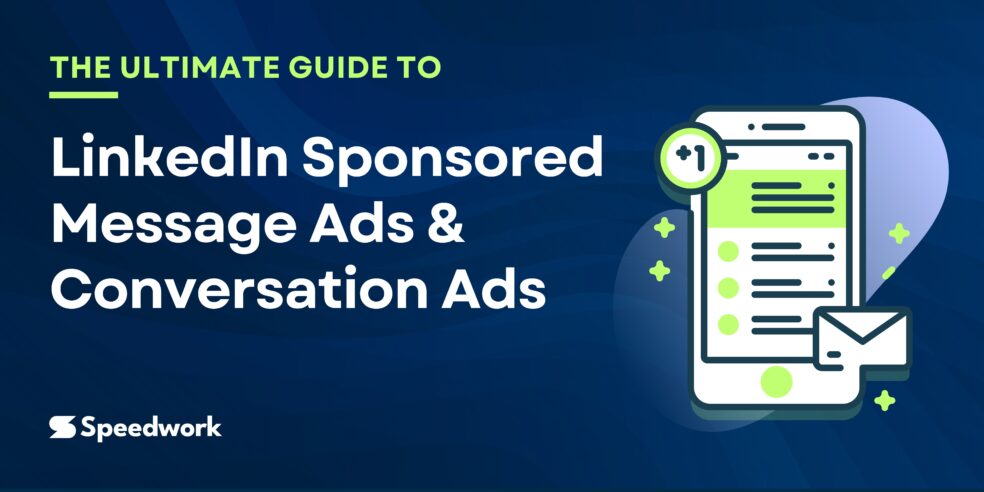LinkedIn has become one of the most effective tools for promoting B2B advertising, providing numerous opportunities to reach professionals around the globe. Out of all the ad formats, LinkedIn-sponsored ads have garnered a lot of popularity, mainly LinkedIn-sponsored messages and LinkedIn conversation ads. Such ad types can engage with audiences and offer opportunities to interact with one’s target consumer that ‘regular’ advertisements cannot provide.
Read on for the ultimate guide to understand LinkedIn-sponsored ads, how the ad works, and the common measures that are adopted for a successful advertising campaign. From this guide, both the advanced marketer and one who is just getting acquainted with LinkedIn advertising will be able to satisfy their need to see a return on investment.
What Are LinkedIn Sponsored Message Ads?
LinkedIn sponsored messages are a subcategory of the LinkedIn sponsored ads tool, which allows you to send direct messages to your target audience’s inbox on LinkedIn. LinkedIn-sponsored messages differ from ordinary display ads as businesses can promote content directly to members.
These types of ads are also immensely beneficial for B2B marketing strategies, given that relationship building is vital in this type of marketing. Too, LinkedIn-sponsored messages can contain a call-to-action (CTA), for instance, a link to the webinar, a downloadable resource, or any kind of offer, making the conversation very conversion-oriented.
LinkedIn Sponsored Ads Specs: Understanding the Basics
Prior to manufacturing your LinkedIn-sponsored ads, you need to know the overall specs. Understanding these will help you create ads that meet LinkedIn policies while achieving the best results.
- Ad Format: Both LinkedIn-sponsored messages and conversation ads are delivered to the inbox.
- Character Limit: The essential aspects of messages must be clear and concise, as the recommended length is up to 500 characters for the first message.
- Call-to-Action (CTA): Make sure that your CTA is pointed and persuasive enough for the recipient of your message to follow the instructions.
- Image Dimensions: If your message contains an image, the size of the image should be 300 x 250 pixels.
LinkedIn Conversation Ads: A New Way to Engage
LinkedIn conversation ads are an extension of LinkedIn-sponsored messages and are more engaging because you can converse with your audience. Unlike conventional LinkedIn-sponsored ads, it is possible to build a dialogical flow with conversation ads that allow the recipient to choose the path through the conversation. This format is most useful for lead generation, increasing attendance for events, and distributing content.
For instance, a LinkedIn conversation ad could ask, “Are you interested in the latest product?” Depending on the user’s reply, the ad will lead the user to more information, a sign-up form, or a similar CTA.
Conversational flow is another benefit of this approach. Not only does it increase the engagement rate of your leads, but it also helps you to naturally filter your leads, as the flow of the conversation is dependent on the answers to questions provided by the lead.
Best Practices for LinkedIn Sponsored Message Ads & Conversation Ads
To make the most of your LinkedIn-sponsored ads, consider the following best practices:
1. Personalization is Key:
The more direct the message is, especially to the party that is being targeted, the better. Get familiar with the recipient and use their name, the name of the company they work for, or the industry the company belongs to.
2. Keep It Short and Sweet:
With the character limit applied, be sure to count every word. Focus on value first and call-to-action second.
3. Test Different CTAs:
Try out different CTAs to identify which creates the most engagement among your target market. Whether it’s “Learn more,” “Register now” or “Download,” the right call-to-action can make a huge difference to the conversion ratio.
4. Monitor Performance and Adjust:
Routinely evaluate the effectiveness of your LinkedIn-sponsored ads and make the necessary changes to improve results. LinkedIn offers great tracking reporting, which can be useful for making changes by the time you need to recycle the advertising message.
For a deeper dive into optimizing your LinkedIn campaigns, check out our Spotify episode on ‘Marketing LinkedIn Sponsored Message Ads and Conversation Ads.’
Integrating LinkedIn Sponsored Ads with Other Platforms
The use of LinkedIn-sponsored ads can be complemented by other platforms. For instance, by marrying your LinkedIn-sponsored messages with your customer relationship management (CRM) tool, you can streamline lead management. Integrating the leads generated from LinkedIn with a tool like Salesforce means that you are able to follow them up so that no potential customer is left in the dark.
For more information on this integration, refer to our blog on ‘ How to Integrate LinkedIn Ads with Salesforce: Push Leads, Sync Lists’.
LinkedIn Ads Benchmarks
Knowledge of these benchmarks is essential since it allows you to establish the right level of expectation on what you wish to achieve with your campaigns and track their performance. LinkedIn-sponsored ads have rather specific performance indicators, and it can be helpful to get some insight into the industry average for different KPs.
For a comprehensive overview of what to expect from your LinkedIn campaigns, including click-through rates, conversion rates, and cost-per-click, take a look at our blog on ‘LinkedIn Ads Benchmarks for 2024: What You Need to Know’.
Conclusion
LinkedIn-sponsored ads such as Linkedin-sponsored messages and conversation ads are powerful tools for communicating with the right audience. Remember, a compelling message to the audience at the correct stage in the buying cycle is the cornerstone of effective marketing communication. With LinkedIn constantly growing to include more extensive advertising options, it is essential for marketers to read about new trends and methods available. Whether you are targeting a board audience or specific target market, the insights contained in this guide will be helpful in decoding the dynamics of LinkedIn advertising and, ultimately, help you to achieve the best results possible.
